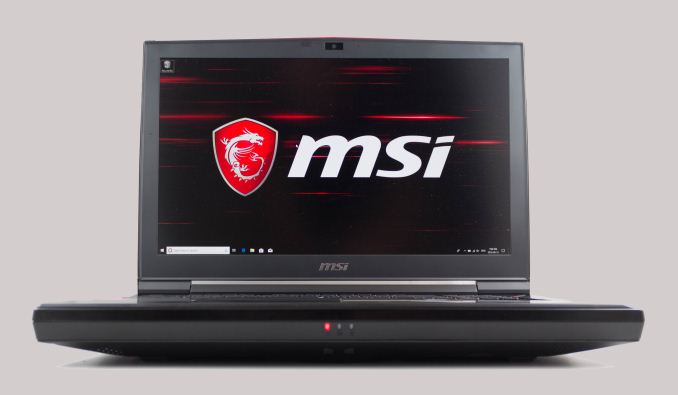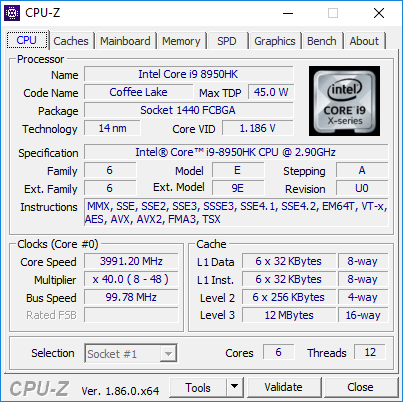The MSI GT75 Titan Laptop Review: Hex-Core DTR
by Brett Howse on September 13, 2018 9:00 AM EST- Posted in
- Laptops
- Gaming
- MSI
- Pascal
- Coffee Lake
- Coffee Lake-H

The gaming laptop segment is one of the most profitable around, and MSI has focused their laptops almost exclusively on this market for the last couple of years. Today we are taking a look at the MSI GT75 Titan, otherwise affectionately known as the GT75 Titan-093. The GT lineup is the top of the range for MSI, and the GT75 Titan offers all the accoutrements you’d be expecting in a gaming laptop.
MSI continuously updates their GT lineup with the latest equipment, and for the 17.3-inch GT75 they’ve moved exclusively to the hex-core Intel Coffee Lake lineup, with the Core i7-8750H, Core i7-8850H, and Core i9-8950HK options. These are all 45-Watt CPUs, but the Core i9 offers overclocking in addition to a higher base and boost frequency at stock speeds.
GPU options are all NVIDIA. AMD doesn’t offer Vega in any sort of laptop form factor at the moment, so for now, NVIDIA has this market all to themselves. The GT75 can be had with a GTX 1070, GTX 1070 SLI, or GTX 1080.
There’s lots of storage options, starting with just a 1 TB 7200 rpm drive, and then adding in SSDs for the boot drive, with either a 256 GB SATA, 512 GB SATA, or 512 GB NVMe or dual 512 GB NVMe in RAID on the higher models. If you want to add your own storage, the laptop offers 3 M.2 slots so you can mix and match flash storage.
The low-end models come with a single SODIMM of 16 GB DDR4-2400, and the high-end models come with 2x16 GB DDR4-2667. Since this is a gaming laptop, it does of course offer SODIMM slots, so you can add more RAM after purchase, unlike an Ultrabook. There are four slots, so the laptop could handle up to 64 GB of DDR4.
| MSI GT75 Titan | ||||||
| Component | GT75 TITAN-058 | GT75 TITAN-055 | GT75 TITAN-056 | GT75 TITAN-094 | GT75 TITAN-093 (Model Tested) |
GT75 TITAN-04K-071 |
| CPU | Intel Core i7-8750H 6 Core, 12 Thread 2.2 - 4.1 GHz 9MB Cache, 45W TDP |
Intel Core i7-8850H 6 Core, 12 Thread 2.6 - 4.3 GHz 9MB Cache, 45W TDP |
Intel Core i9-8950HK 6 Core, 12 Thread 2.9 - 4.8 GHz 12MB Cache, 45W TDP |
|||
| GPU | NVIDIA GTX 1080 2560 CUDA Cores, 160 TU, 64 ROPs 1556-1733MHz 10 Gbps GDDR5X 256-bit 8GB |
|||||
| RAM | 16GB DDR4 2400 x 1 4 SODIMM Slots 64 GB Max |
16GB DDR4 2666 x 1 4 SODIMM Slots 64 GB Max |
16GB DDR4 2666 x 2 4 SODIMM Slots 64 GB Max |
|||
| Display | 17.3" 1920x1080 120Hz TN 170° viewing angle sRGB |
17.3" 3840x2160 60Hz IPS Adobe RGB |
||||
| Storage | 256GB M.2 SATA 1 TB 7200rpm 3 M.2 slots |
512GB M.2 SATA 1 TB 7200rpm 3 M.2 slots |
1 TB 7200rpm 3 M.2 slots |
512GB M.2 NVMe 1 TB 7200rpm 3 M.2 slots |
512GB M.2 NVMe x 2 (1TB RAID) 1 TB 7200rpm 3 M.2 slots |
|
| Network | Killer Gigabit Ethernet Killer Wireless-AC 1550 2x2:2 Bluetooth 5.0 |
Aquantia 10Gbps Ethernet Killer Wireless-AC 1550 2x2:2 Bluetooth 5.0 |
||||
| I/O | USB 3.1 Gen2 Type-A x 5 USB-C Thunderbolt 3 x 1>br />SDXC mini DisplayPort 1.2 HDMI 2.0 |
|||||
| Keyboard | SteelSeries Mechanical Per-Key RGB with Anti-Ghost | |||||
| Audio | ESS Sabre HiFi DAC 3.5mm Headphone, Mic, Line In, Line Out Dynaudio Tech Speakers 3W Stereo + 5W Subwoofer |
|||||
| Battery | 8 cell 75Wh Li-Ion | 8 cell 90Wh Li-Ion | ||||
| AC Adapter | 330W | 330W | 2 x 230W | |||
| Dimensions | 428 x 314 x 57.9 mm 16.85 x 12.36 x 2.28 inches |
|||||
| Weight | 4.56 kg 10.05 lbs |
4.50 kg 9.92 lbs |
4.56 kg 10.05 lbs |
|||
| MSRP | $2,799 | $2,999 | $2,799 | $3,299 | $3,999 | $4,499 |
As you can see, there's quite a few different models available depending on what channel you end up purchasing from, and of course the third party resellers of MSI will likely be able to customize further. There's also a single model called the GT75 Titan-057 which comes with a GTX 1070, and costs $2,399 that's not in the above table in order to prevent it becoming even more complicated.
MSI offers two display choices, with a 120 Hz 1920x1080 TN panel, or a 3840x2160 60 Hz IPS option with 100% Adobe RGB gamut support. Both displays offer G-SYNC functionality as well.
Finally, there’s plenty of inputs, with five USB 3.1 Gen 2 Type-A ports, a USB-C Thunderbolt 3 port, and an SD card slot. There are also four 3.5 mm audio jacks, a Killer Wireless-AC 1550 802.11ac 2x2 network card, and, the first laptop we’ve reviewed with a 10 Gigabit Aquantia Ethernet port.
But wait – there’s more. MSI has outfitted the GT75 with a fully mechanical keyboard from SteelSeries, with per-key RGB lighting.
Yes it’s big. Yes the bezels are large. Yes it weighs just over 10 lbs. But this system is designed for performance, not actually sitting in one's lap, so we’ll have to see how it does with its primary function. But first, let’s go over the design.











48 Comments
View All Comments
RSAUser - Saturday, September 15, 2018 - link
Not really, at 3ft distance and 17", you can definitely notice the difference in sharpness between 1080p and 4k, heck, I can notice it between 1440p and 4k.The TN panel should have at least been 1440p.
milkod2001 - Tuesday, September 18, 2018 - link
Yeah, well how is windows scaling working on 17''laptop with 4k screen?ralstonater - Monday, October 1, 2018 - link
I have the 4k-071 model and I can verify that the scaling works and looks just fine on my laptop :)milkod2001 - Tuesday, September 18, 2018 - link
At 3ft distance if you can notice any difference in sharpness between 1080 and 4k on 17''screen you must be using 1'' thick glasses with some laser enhancements and binoculars attached. Bet you got there night vision too. Haha.darkich - Sunday, September 16, 2018 - link
You're either crazy either have serious eyesight impairment.1080p TN on a 17" laptop with this price and this GPU is an absolute insult to common sense.
If you are fine with paying that much money for staring into something that looks worse than a $300 tablet screen, well..no further comment.
milkod2001 - Tuesday, September 18, 2018 - link
The absolute insult for me would be paying nearly 3 grand for laptop. No matter how great it is, it is aimed at stupid people. 17'' laptop will sit on table 100% of times. Why not spend 3grand on desktop with 2 times better performance and at least 27''screen? Kinda silly, don't you agree?1080p on 17" is perfectly fine. I don't expect 4k on 17'' screen scaling great using Windows.
zoxo - Thursday, September 13, 2018 - link
120Hz screenDanNeely - Thursday, September 13, 2018 - link
The extra size should make this significantly quieter than a thin and light gaming laptop.This will comfortably do 1080p 120hz, and has a decent margin to keep being able to do so for a few years before frame rates fall too low vs something with a lower end GPU that thermal throttles harder because of size.
That said, I really would like to see 15.6/17.3" 1440p laptop screens since that appears to be the sweet spot for current generation GPUs.
bennyg - Friday, September 14, 2018 - link
You'd think that, but all the high end DTRs have pretty similar jet turbines under load reaching above 55dBa, because they're all set to turbo themselves as high as they'll go, which is almost always limited by cooling. Idle and part load noise is a tradeoff between temps and noise up to the user via fan control schemesRSAUser - Saturday, September 15, 2018 - link
You can set them all to be adaptive/set to screen resolution.Nvidia control panel > Manage 3D settings > Power management mode to adaptive.
It's one of the first changes I make on any Nvidia or AMD card, what's the point in pushing twice the amount of frames needed, I'd rather use less power and have the fan quieter.